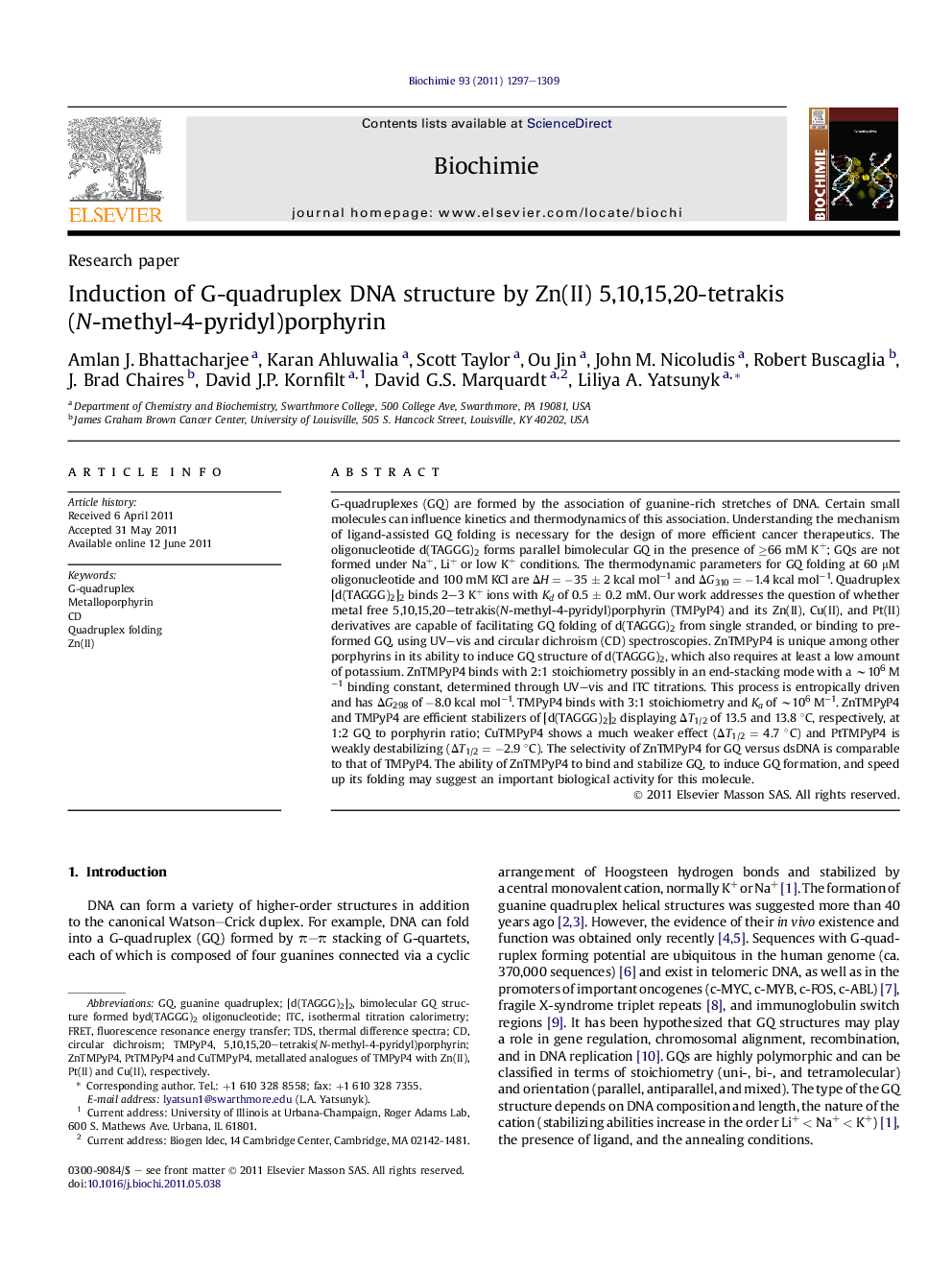| کد مقاله | کد نشریه | سال انتشار | مقاله انگلیسی | نسخه تمام متن |
|---|---|---|---|---|
| 1952481 | 1057211 | 2011 | 13 صفحه PDF | دانلود رایگان |

G-quadruplexes (GQ) are formed by the association of guanine-rich stretches of DNA. Certain small molecules can influence kinetics and thermodynamics of this association. Understanding the mechanism of ligand-assisted GQ folding is necessary for the design of more efficient cancer therapeutics. The oligonucleotide d(TAGGG)2 forms parallel bimolecular GQ in the presence of ≥66 mM K+; GQs are not formed under Na+, Li+ or low K+ conditions. The thermodynamic parameters for GQ folding at 60 μM oligonucleotide and 100 mM KCl are ΔH = −35 ± 2 kcal mol−1 and ΔG310 = −1.4 kcal mol−1. Quadruplex [d(TAGGG)2]2 binds 2–3 K+ ions with Kd of 0.5 ± 0.2 mM. Our work addresses the question of whether metal free 5,10,15,20–tetrakis(N-methyl-4-pyridyl)porphyrin (TMPyP4) and its Zn(II), Cu(II), and Pt(II) derivatives are capable of facilitating GQ folding of d(TAGGG)2 from single stranded, or binding to preformed GQ, using UV–vis and circular dichroism (CD) spectroscopies. ZnTMPyP4 is unique among other porphyrins in its ability to induce GQ structure of d(TAGGG)2, which also requires at least a low amount of potassium. ZnTMPyP4 binds with 2:1 stoichiometry possibly in an end-stacking mode with a ∼106 M−1 binding constant, determined through UV–vis and ITC titrations. This process is entropically driven and has ΔG298 of −8.0 kcal mol−1. TMPyP4 binds with 3:1 stoichiometry and Ka of ∼106 M−1. ZnTMPyP4 and TMPyP4 are efficient stabilizers of [d(TAGGG)2]2 displaying ΔT1/2 of 13.5 and 13.8 °C, respectively, at 1:2 GQ to porphyrin ratio; CuTMPyP4 shows a much weaker effect (ΔT1/2 = 4.7 °C) and PtTMPyP4 is weakly destabilizing (ΔT1/2 = −2.9 °C). The selectivity of ZnTMPyP4 for GQ versus dsDNA is comparable to that of TMPyP4. The ability of ZnTMPyP4 to bind and stabilize GQ, to induce GQ formation, and speed up its folding may suggest an important biological activity for this molecule.
Figure optionsDownload high-quality image (143 K)Download as PowerPoint slideHighlights
► d(TAGGG)2 folds into parallel quadruplex in >66 mM KCl, but not in Li+ or Na+.
► ZnTMPyP4 but not TMPyP4, CuTMPyP4, or PtTMPyP4 can induce GQ structure of d(TAGGG)2.
► GQ stabilizing abilities decrease in the order ZnTMPyP4 ∼ TMPyP4 > CuTMPyP4 > PtTMPyP4.
► 2 ZnTMPyP4 bind quadruplex in end-on mode with Ka ∼ 106 M−1and ΔG of −8.0 kcal/mol.
► ZnTMPyP4 speeds up d(TAGGG)2 folding into GQ implying possible biological role.
Journal: Biochimie - Volume 93, Issue 8, August 2011, Pages 1297–1309